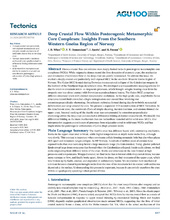| dc.contributor.author | Wiest, Johannes | |
| dc.contributor.author | Osmundsen, Per Terje | |
| dc.contributor.author | Jacobs, Joachim | |
| dc.contributor.author | Fossen, Haakon | |
| dc.date.accessioned | 2020-05-04T07:01:13Z | |
| dc.date.available | 2020-05-04T07:01:13Z | |
| dc.date.issued | 2019 | |
| dc.Published | Wiest, Osmundsen, Jacobs, Fossen. Deep Crustal Flow Within Postorogenic Metamorphic Core Complexes: Insights From the Southern Western Gneiss Region of Norway. Tectonics. 2019;38(12):4267-4289 | eng |
| dc.identifier.issn | 1944-9194 | en_US |
| dc.identifier.issn | 0278-7407 | en_US |
| dc.identifier.uri | https://hdl.handle.net/1956/22070 | |
| dc.description.abstract | Viscous crustal flow can exhume once deeply buried rocks in postorogenic metamorphic core complexes (MCCs). While migmatite domes record the flow dynamics of anatectic crust, the mechanics and kinematics of solid‐state flow in the deep crust are poorly constrained. To address this issue, we studied a deeply eroded and particularly well‐exposed MCC in the southern Western Gneiss Region of Norway. The Gulen MCC formed during Devonian transtensional collapse of the Caledonian orogeny in the footwall of the Nordfjord‐Sogn detachment zone. We developed a semiquantitative mapping scheme for ductile strain to constrain micro‐ to megascale processes, which brought eclogite‐bearing crust from the orogenic root into direct contact with Devonian supradetachment basins. The Gulen MCC comprises different structural levels with distinct metamorphic evolutions. In the high‐grade core, amphibolite‐facies structures record fluid‐controlled eclogite retrogression and coaxial flow involving vast extension‐perpendicular shortening. Detachment mylonites formed during ductile‐to‐brittle noncoaxial deformation and wrap around the core. We present a sequential 3‐D reconstruction of MCC formation. In the detachment zone, the combined effects of simple shearing, incision/excision, and erosion thinned the upper crust. Internal necking of the ductile crust was compensated by extension‐perpendicular shortening within the deep crust and resulted in differential folding of distinct crustal levels. We identify this differential folding as the main mechanism that can redistribute material within solid‐state MCCs. Our interpretation suggests a continuum of processes from migmatite‐cored to solid‐state MCCs and has implications for postorogenic exhumation of (ultra‐)high‐pressure rocks. | en_US |
| dc.language.iso | eng | eng |
| dc.publisher | American Geophysical Union | en_US |
| dc.rights | Attribution CC BY | eng |
| dc.rights.uri | http://creativecommons.org/licenses/by/4.0/ | eng |
| dc.title | Deep Crustal Flow Within Postorogenic Metamorphic Core Complexes: Insights From the Southern Western Gneiss Region of Norway | en_US |
| dc.type | Peer reviewed | |
| dc.type | Journal article | |
| dc.date.updated | 2020-01-30T14:42:02Z | |
| dc.description.version | publishedVersion | en_US |
| dc.rights.holder | Copyright 2019 The Authors | en_US |
| dc.identifier.doi | https://doi.org/10.1029/2019tc005708 | |
| dc.identifier.cristin | 1779154 | |
| dc.source.journal | Tectonics | |

